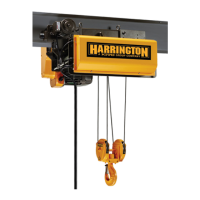23
3.6 Electrical Connections
3.6.1
If the Trolley hoist was supplied without a Power Supply Cable. The installer
must use a UL List power supply cable Type SJ, SJT, SO, SOO, SOOW, ST, STO or of a type at
least equally servicable for the particular application. Rated 90C, 600V minimum. Refer to total
AMP draw and NEC® (ANSI/NFPA 70, “National Electric Code”) guidelines when sizing appropriate
Power Supply Cable gauge. Always consult with a qualified person when appropriate Power
Supply Cable sizing is in question.
3.6.2
Ensure that the voltage of the electric power supply is proper for the trolley hoist.
3.6.3
Do NOT apply electronic soft-start control or voltage varying controls to the RY.
Use of such devices may cause the motor brake and other electrical components to malfunction. The
RY lifting and traversing motions are variable frequency drive (VFD) controlled.
3.6.4
Before proceeding, ensure that the electrical supply for the hoist or trolley has
been de-energized (disconnected). Lock out and tag out in accordance with ANSI Z244.1 “Personnel
Protection -Lockout/Tagout of Energy Sources”.
3.6.5
To avoid a shock hazard, DO NOT perform ANY mechanical or electrical
maintenance on the trolley or hoist within 5 minutes of de-energizing (disconnecting) the trolley or
hoist. This time allows the internal VFD capacitor to safely discharge.
3.6.6
Do NOT remove power to the trolley hoist during operation.
3.6.7
All RY trolley hoists are dual speed hoists and trolleys that are equipped with
VFD’s. The VFD’s are used to control the high and low lifting and traversing speeds. The speeds
come preset from the factory (See Table 3-5). Speed (frequency) can be customized. Refer to
Section 3.8.13 for hoist specific speed ranges and instructions and Section 3.11.5 for trolley
traversing speed ranges and instructions.
3.6.8 Installing Power Supply Cord
1) Refer to Figure 3-12 and the wiring diagram provided with the Hoist.
2) Remove Control Cover.
3) Multiple cable fittings/clamps are available for use on both sides of the Control Panel for the Power
Supply Cord. Loosen the selected cable fitting/clamp and insert the Power Supply Cable. Pull
through enough cable to reach the power supply terminal and securely tighten the cable fitting as
shown in Figure 3-12.
4) Pull the Power Cable to check that it does not move in the cable fitting/clamp.
5) Connect the 3 phase power leads (L1, L2 and L3) and the ground lead of the Power Supply Cable
to the power supply terminals, Red, White, Black and Green/Yellow (ground). Make sure the
terminals are securely tightened and each lead is completely isolated as shown in Figure 3-12.
6) Connection to Electrical Power Source - The Red, White and Black wires of the Power
Supply Cable should be connected to an Electric Power Disconnect Switch or Circuit
Breaker.
7) Fuse/Breaker Capacity -The hoist's power supply should be equipped with current overload
protection such as fuses, which should be selected for 110% to 120% of total listed full load
amperage, and should be dual element time-delay fuses. Refer to the motor nameplate for
the full load amperage draw.
8)
Grounding - An improper or insufficient ground connection creates an
electrical shock hazard when touching any part of the hoist or trolley. In the Power Supply

